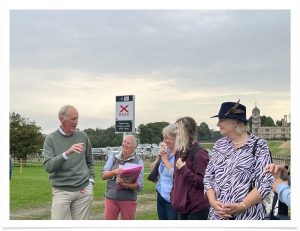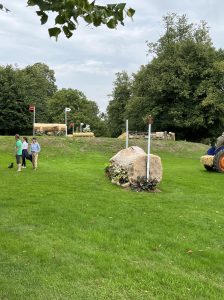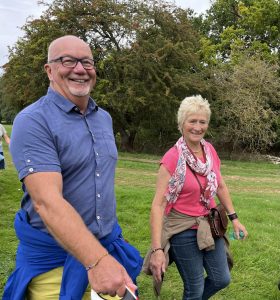Burghley XC Course Walk with Eric Smiley FBHS
 A fine collection of F and I members, plus friends, waited eagerly at fence 2 for a long overdue course walk of Burghley, running at long last after a gap of two years due to Covid. Eric Smiley FBHS soon took control, ably assisted by the wonderful Ann Bostock, and we set off at a good hunting pace! Before we did, however, Eric put to us the various groupings that course walkers would fall into :
A fine collection of F and I members, plus friends, waited eagerly at fence 2 for a long overdue course walk of Burghley, running at long last after a gap of two years due to Covid. Eric Smiley FBHS soon took control, ably assisted by the wonderful Ann Bostock, and we set off at a good hunting pace! Before we did, however, Eric put to us the various groupings that course walkers would fall into :
- RIDERS – If so, think of that horse YOU are riding. What is the course designer asking of me? Have I done my homework to do so? Is my horse younger/older/experienced/less experienced?
- TRAINER – this will be filled with extensive detail. However a celebrity trainer will be walking with lots and lots of anecdotes to the gathered crowd!
- OWNER
- INTERESTED PARTY
Derek di Grazia (long time Kentucky and Tokyo designer) has a conundrum. The world championships is in a couple of weeks so the field is less experienced. The sport is changing and people, not from the equestrian world, are looking intensely at us. Does he cater for the lower levels or cap the level as it must stay at five-star level? Does he use many alternative routes …but horses can get too tired? It’s his first time and all eyes are on him.
What sets Burghley apart from anything else in the world is the terrain. The horses must be fit and up to it. The undulations make it very different from Badminton.
 When Eric was asked how he walks a course, he replied the first walk gets the route, the second explores the choices, the third will be for making your final decisions and the line you feel comfortable for your horse. Any fourth or even fifth walk will be to recheck technicalities such as the leaf pit or the water.
When Eric was asked how he walks a course, he replied the first walk gets the route, the second explores the choices, the third will be for making your final decisions and the line you feel comfortable for your horse. Any fourth or even fifth walk will be to recheck technicalities such as the leaf pit or the water.
Eric reminded us that every single competitor (from Pony Club to 5 star !) is divided into three groups :
Happy to be there!
To complete but uncompetitive.
Competitive top guys who will run quickly.
Like the Pied Piper, Eric marched off at advanced pace and we all followed determined to keep up, some hoping their fitness was sufficient this summer while others blamed the hard ground for lack of it! He commented that the first four fences were full of colour which was helpful so you could just let the horse run and leave it to set itself up. Debbie Melville asked Eric’s opinion on objects placed to the sides of fences to which Eric advised that it helps horses visualise depth and they are much more aware of peripheral vision than their forward vision.
As we entered the area of the three arena fences (generous in his opinion), Eric commented we would see who is already competitive or not depending on whether they were angling or curving lines, and also by the speed in which they came into the arena. Trees make it seem you’re going faster than you think, same effect as coming into the arena. If you’re down on time three minutes in, you can’t make it up.
Marching onto the Discovery Valley, Eric reminded us that a rider should be changing whip hands even as much as 15 to 20 times around just watch Michael Jung! Everything is reliant on good quality PACE (energy, forward, regular) and LINE. Line is down to the rider, if you can’t keep your line you’re in trouble. Of interest to note are the inclusion of crucial and necessary fences with MIMs pins. To avoid unnecessary 11 penalties for a broken pin, they need respect but Eric remarked so should every single fence have respect. Pippa Funnell made an interesting remark on finishing her first round that it jumped big and questioned if MIMs pins allow more use of maximum dimensions?
 The leaf pit was the first very testing challenge and indeed proved very influential. On dropping off the humongous leaf pit the distance is uncertain but it needed to be ridden on a forward three, requiring accurate line. Alternative route A, B, C, D, E and F was certainly circuitous and tested rider’s mental capacity to boot. Eric put it to us, (the F&I’s), that it is our responsibility that the training we do creates speed of thought. A cross country horse needs quickness of thought not the debate Thoroughbred versus Warmblood. They will not think quickly if they are completely dependent on us and we must train cross country horses to think fast.
The leaf pit was the first very testing challenge and indeed proved very influential. On dropping off the humongous leaf pit the distance is uncertain but it needed to be ridden on a forward three, requiring accurate line. Alternative route A, B, C, D, E and F was certainly circuitous and tested rider’s mental capacity to boot. Eric put it to us, (the F&I’s), that it is our responsibility that the training we do creates speed of thought. A cross country horse needs quickness of thought not the debate Thoroughbred versus Warmblood. They will not think quickly if they are completely dependent on us and we must train cross country horses to think fast.
 Food for thought for the instructors / commentators when looking at the triple bar was to think of the choice of words that can make or break pupils/riders. “That’s a let up fence” – is it? There is no such thing at five star. No! dimensions are at a maximum, it is a fence that re-establishes certain qualities -yes, takes the pressure off, yes, etc many fall at let up fences as they don’t take them seriously. When we train horses, we must take out the difficulty of jump and height, make it simple and don’t clutter the horses mind. A lot of horses do not have good canters. Do not jump from the canter until they have a good canter, jump from trot! Make it easy!
Food for thought for the instructors / commentators when looking at the triple bar was to think of the choice of words that can make or break pupils/riders. “That’s a let up fence” – is it? There is no such thing at five star. No! dimensions are at a maximum, it is a fence that re-establishes certain qualities -yes, takes the pressure off, yes, etc many fall at let up fences as they don’t take them seriously. When we train horses, we must take out the difficulty of jump and height, make it simple and don’t clutter the horses mind. A lot of horses do not have good canters. Do not jump from the canter until they have a good canter, jump from trot! Make it easy!
The mission for the back end of the course is to get home. One jump is in the water, so keep the horse focused. Do not chase the clock on tired horses, they are leg weary. Eric reminded us, riders owe it to the horse to keep themselves thinking. Riders must keep hydrated , by the end of the course they must have had enough intake of fluid to keep them thinking as quickly as they expect their horse to.
Eric’s thoughts were that it was definitely testing and he hoped that we had all jumped clear – of course we had! We had all walked great lines, with great pace and a great celebrity trainer! Thank you Eric!
